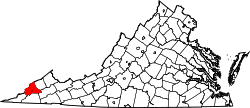Osaka, Virginia | |
|---|---|
| Coordinates: 36°56′49″N82°48′39″W / 36.94694°N 82.81083°W [1] | |
| Country | United States |
| State | Virginia |
| County | Wise |
| Area | |
• Total | 0.431 sq mi (1.12 km2) |
| • Land | 0.431 sq mi (1.12 km2) |
| • Water | 0 sq mi (0 km2) |
| Elevation | 1,801 ft (549 m) |
| Population (2020) | |
• Total | 132 |
| • Density | 306.3/sq mi (118.3/km2) |
| Time zone | UTC-5 (Eastern (EST)) |
| • Summer (DST) | UTC-4 (EDT) |
| GNIS feature ID | 1493381 [1] |
Osaka is a Census-designated place and coal town located in Wise County, Virginia, United States, served by a (now vanished) branch line of the Appalachia to Stonega railroad that ran along Mud Lick Creek to Roda, which was built in 1896 by Interstate Railroads. [2] [3]


